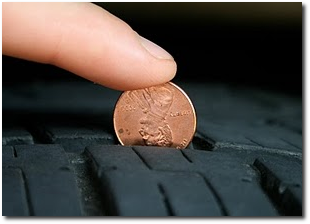Tire Tread Depth

Your tires are simply the most important part of your vehicle. as a matter of fact without them you don't really even have one. Tire tread depth is a concern for every driver out there, whether you're hitting the Rubicon Trail or driving to soccer practice everyone would like as much rubber as possible. Keeping your tires in good condition and making them last as long time will not only keep you safe, but save you a little money as well.
Checking tire tread depth on a consistent basis is important to the life of a tire for two reasons. One, you're getting a good look at your tires regularly to make sure there is nothing harmful to be aware of. Plus, you will be able to measure different sections of your tires to make sure they are wearing at a consistent rate. This will not only allow you to get the most life out of them, but make sure nothing serious is causing the abnormal wear. Rotating your tires on a regular basis is best thing you can do for tire life. Always set up a mileage plan and follow it as closely as possible. Usually rotating your tires between 6000 and 8000 miles is good, unless otherwise specified by your tire retailer or car manufacturer.
It is very difficult to accurately measure tire tread depth at home without a tread depth gauge. However when tires near the end of their life, a penny can be used to confirm tread depth. If you can see Lincoln’s entire head, then there is approximately 2/32 of treat remaining. This is the most widely accepted minimum tread depth at which tires should be removed from your vehicle. There are tread wear indicator bars in the main grooves of the tire that become level with the tread surface at approximately 2/32 remaining tread. This is not recommended and tires at this depth should not be driven on long especially in the winter. 3-4/32 is a much more safe tread depth to replace tires at. Visit a local tire dealer to get your tires checked with a depth gauge, and a professional opinion, if you believe your tires are nearing the end.
